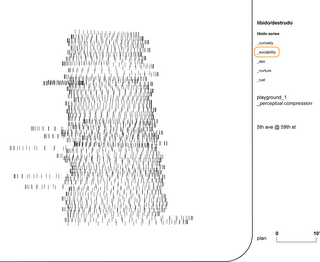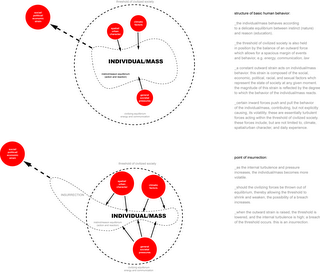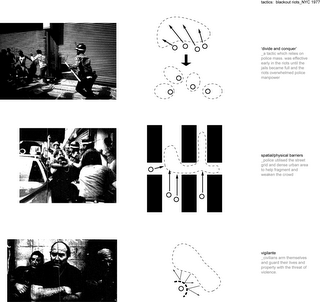in keeping with the four methods of mitigating insurrection as previously set forth, we now examine an architectural solution for such. in my view, the third option, a time/space detour is likely the most comprehensible, will at the same time neing the most realistically effective. the architecture is the physical manifestation of a set of rules, or parameters, that are required to engage a space of insurrection.
the time/space detour is an active anti-insurrection device. it is an "intelligent" and device that will adapt to any physical space. The architecture creates an "infinite" corridor, winding through space and time, redirecting insurrection from time/space "A" into an elongated time/space "B".
the time/space detour is an active anti-insurrection device. it is an "intelligent" and device that will adapt to any physical space. The architecture creates an "infinite" corridor, winding through space and time, redirecting insurrection from time/space "A" into an elongated time/space "B".
"Everyone has a theory of human nature. Everyone has to anticipate the behavior of others..."
-Steven Pinker
The Blank Slate
2002
This film is a joint project between myself and Maurizio Mucciola. The film explores how notions of 'potential' and 'human nature' can be experienced in the city, at once objectively and subjectively.


why just play the game, when the rules must be redefined?.......answer: too much redefinition required, thus leading to misunderstanding.
methods to prevent human insurrection (social and self-)...
a) remove the people from a place altogether
b) remove human instincts; in other words, Pavlovian re-conditioning or psycho-somatic engineering
c) create a time-space shift that temporarily detaches people and the potential insurrection from the current time-space, thus restoring the equilibrium forces of society
d) create a device that balances between the libido and destrudo in people, thus neutralizing the potential for insurrection
see recent 060717 presentation at right.....
in·stinct: 'in-"sti[ng](k)t
Function: noun
1 : a largely inheritable and unalterable tendency of an organism to make a complex and specific response to environmental stimuli without involving reason
2 : behavior that is mediated by reactions below the conscious level
Source: Merriam-Webster's Medical Dictionary, © 2002 Merriam-Webster, Inc.
Do we really know what instinct is? Everyone has some sense of what it is, but for the concept to fully work with the argument of "instinct=insurrection", it is crucial that we all understand it in the same terms.
Regardless of its formal meaning, we typically use and understand the word 'instinct' to describe certain behaviors, habits, and rituals of humans and animals that are not learned, but that are somehow hard-wired into the brain and operate on a subconscious level. Because of this, we often use the term as a sort of catch phrase to describe any behavior or act for which we cannot perceive or ascertain an immediate or obvious cause. Therein lies a slight but important dissonance between the colloquial and scientific usage of the term. In other words, we mistakingly assign the cause a particular behavior to 'instinct', when in fact the true cause may be purely rational and calculated or learned from an external or societal source. We treat instinct as a scapegoat for what may be a lack of judgment, but then again, 'judgment' is based on ethics; a seemingly human construct.
In colloquial usage, and even sometimes in formal usage, we tend to limit 'instinct' to animals. Even the lexicon entry seen above refers to faunal systems, suggesting that a brain, or consciousness, is required for an organism to have 'instincts'. This is a flawed conclusion, however, as it is apparent that 'instinct' exists in all lifeforms, including non-cerebral organisms such as viruses and plants. For this reason, it is appropriate to say that any system has a set of rules engrained within it; behavior that is not learned or assigned but that is inherent to the diagram of the system.
developing incomplete list of instincts abstractly applicable to a system:
desire (action, reaction)
procreation (action)
fear (reaction)
attraction (reaction)
violence (action, reaction)
Function: noun
1 : a largely inheritable and unalterable tendency of an organism to make a complex and specific response to environmental stimuli without involving reason
2 : behavior that is mediated by reactions below the conscious level
Source: Merriam-Webster's Medical Dictionary, © 2002 Merriam-Webster, Inc.
Do we really know what instinct is? Everyone has some sense of what it is, but for the concept to fully work with the argument of "instinct=insurrection", it is crucial that we all understand it in the same terms.
Regardless of its formal meaning, we typically use and understand the word 'instinct' to describe certain behaviors, habits, and rituals of humans and animals that are not learned, but that are somehow hard-wired into the brain and operate on a subconscious level. Because of this, we often use the term as a sort of catch phrase to describe any behavior or act for which we cannot perceive or ascertain an immediate or obvious cause. Therein lies a slight but important dissonance between the colloquial and scientific usage of the term. In other words, we mistakingly assign the cause a particular behavior to 'instinct', when in fact the true cause may be purely rational and calculated or learned from an external or societal source. We treat instinct as a scapegoat for what may be a lack of judgment, but then again, 'judgment' is based on ethics; a seemingly human construct.
In colloquial usage, and even sometimes in formal usage, we tend to limit 'instinct' to animals. Even the lexicon entry seen above refers to faunal systems, suggesting that a brain, or consciousness, is required for an organism to have 'instincts'. This is a flawed conclusion, however, as it is apparent that 'instinct' exists in all lifeforms, including non-cerebral organisms such as viruses and plants. For this reason, it is appropriate to say that any system has a set of rules engrained within it; behavior that is not learned or assigned but that is inherent to the diagram of the system.
developing incomplete list of instincts abstractly applicable to a system:
desire (action, reaction)
procreation (action)
fear (reaction)
attraction (reaction)
violence (action, reaction)


continued from friday 23 june....
One of Kubrick's best examples of his commentary on the natural human state and its place in society is the 1971 film, A Clockwork Orange. The main character, Alex, is an ultra-violent, maniacal, animalistic sociopath living in London in the not-so-far-away future. He spends his days and hours with his three droogs, beating and robbing and raping and killing, with the most natural of ease and disaffection. This behavior continues unchecked - except for the occasional mutiny within in the group that Alex must supress - until one night Alex is betrayed by his gang, and captured by the police for murder. He then goes to prison, where he is eventually enrolled in a state program to "cure" the criminal mind with an experimental new technique. The result is that Alex has been rendered incapable of performing any violent or sexual act, for once the thought enters his mind, his body turns against itself in excruciating pain and sickness. He finds himself at the mercy (or lack thereof) of all the characters he previously hurt, until he can no longer take the torture and attempts suicide. This prompts the state to revert his social conditioning in a desperate act of 'damage-control', returning Alex to his natural state of ultra-violence and disaffection.
The moral of the story which Kubrick is cynically trying to convey is that the human is by nature, a violent and insurgent animal, and to remove that behavior is destructive and unnatural. Kubrick is presenting the notion that society, or the artificial system that we have created for ourselves to keep our violent, natural behavior in check, is actually the villain, and that it actually creates more harm than good. This concept can be seen in many aspects of the film, from the derelict urban social housing system, to the Nazi-esque prison system, to the faults of modern science and technology. Kubrick is not making the case that everyone should lose all sense of restraint, but rather he is suggesting that too much society (science, technology, law) is actually bad for the human being.
The mappings depict the relationships and actions of the characters in the key scenes throughout the film. All characters have a zone of influence, which may operate above or below the others'. There is a constant entity representing 'society', who's zone of influence contains anyone operating within 'normal' societal behavior. Anyone outside this zone might be considered 'deviant', but again these labels are part of Kubrick's cynicism. The running curves are mapping the intensity of 'violence' and 'fear', as well as the intersections of these states, for each of the main villains and victims in order to examine the relationships of action and reaction. Notice that the villains (deviant) tend to have more volatile curve relationships than the victims (normal).





BLACKOUT!
As a historical example of the instinct of insurrection, we can examine the blackout that occurred in New York City on 13 July 1977. As soon as the electricity was out, the looting and rioting began citywide. Referring to the insurrection model, the threshold contracted, and with mix of high economic and social strain and an already volatile mass, the insurgency was inevitable. Police were grossly outnumbered, and without electricity, had very little communciation or resources. Arson and looting were rampant and widespread. Ordinary citizens became heroes by turning to vigilante justice while guarding their property and lives....using the threat violence to protect themselves.


The above diagrams are basic models of insurrections; one on the individual scale, and one on the larger, social scale. The diagrams are based on a theoretical insurrection model, that through continued research, will be able to accomodate and describe insurrections in all systems, not just anthropomorphic.
It is crucial to understand how the term 'instinct' is used in these discussions. When we are discussing human and human society, the term 'instinct' has a widely understood meaning. However, the same term can be applied to all systems, and should be understood as describing any elemental, innate, and inherent behavior of a unit or organism.


The argument that human nature and instinct are the root causes of all insurrection is highly controversial. It may also be considered highly subjective, and to some people, may appear as a gross generalization for something as complex as the concept of ‘insurrection’. However, despite the intricacy and multiplicity of most insurrections, their basic structure or diagram can be described through elemental figures and forces, that is to say, a set of rules.
While on the surface most insurrections seem to be invariably societal and specific to the situation at hand, all of these incidents are in fact composed of the actions of people. Although there may be natural forces that factor in to the conflict, ultimately, it is the decisions and behavior of human beings that create insurrections. These decisions and behaviors may be based on the action and reaction to external stimuli, but there must be some sort of a priori instructions for this to take place. Of course, one can maintain that the difference between humans and other animals is our ability to be self-conscious, thus being able to have morals, and thereby allowing us to create extremely complex social structures. But when one examines social structures of other animals, such as chimpanzees or honeybees, which also live in very complex societies, the least common denominator between humans and animals decreases. This is because we are still animals, and our instinctive behavior is kept ‘civilized’ only by external constraints which we have invented and developed for ourselves over the last 200,000 years.
In his films, director Stanley Kubrick is a virtuoso at examining and expressing examples of raw human nature. While each film may focus on different aspects of human instinct, there is an apparent consistency of this subject matter throughout his oeuvres.
more to follow...
What is an insurrection?.....
What causes an insurrection?.....
Why is 'insurrection' an inherent element of the human condition?.....
What causes an insurrection?.....
Why is 'insurrection' an inherent element of the human condition?.....